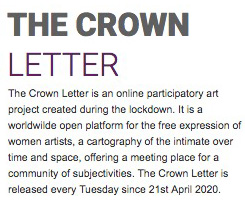Valeria Troubina

Из размышлений на тему собственного положения … и наблюдения за всем происходящим со стороны. У меня тогда в 14м году в Луганске было именно такое ощущение, я вроде бы ни при чем, и даже в безопасности, но глубоко под водой и нечем дышать, а мимо, на поверхности проплывет лодка жизни, которая похожа одновременно и на пулю по конфигурации и на гроб … и даже думаешь что можно вынырнуть на свет, но зрелище завораживает как сон!
This is a reflection on my own situation … and my observation of everything that is happening from the outside. In 2014, in Lugansk, I felt like I wasn’t involved, that I was safe, but that I was somehow deep underwater and couldn’t breathe, and that life, like a boat, floated by on the surface. Here it looks like a bullet or a coffin… and it seems like you could swim up into the light, it is like a vision in a dream!
Michelle Deignan
Liza Dimbleby

Ruth Maclennan

The following is a letter I wrote to the curator I was working with in 2013.
‘I have decided on a title for the exhibition. The title is ‘The faces they have vanished’. It is inspired by a quote from a film maker in 1937, about the faces that appear in films vanishing, and reappearing, only to vanish again, so evoking the magic of the moving image, and also its spectral quality. For me ‘they have vanished’ suggests the faces of poets and artists, that we know from photographs – who appear so distant in the photographs but whose writings are so immediate and contemporary. It suggests the artists and poets, and many other unknown people, who were ‘disappeared’ during the Soviet period (Mandelshtam et al). ‘The faces’ is somehow impersonal, and yet a face is personal, unique.
Katja Stuke

(Google street view 2015) Apr 20. 2022.
Alisa Berger
Natacha Nisic

Ceramic yellow and plastic blue, still fighting
Anne Brunswic

La permanence 4.
Même décor. Même bruit de fond. Les masques chirurgicaux des examinateurs pendent sous le nez, ou sous le menton. Entre une jeune femme africaine, longiligne, voile noir, jupe longue noire, anorak noir, masque chirurgical. Elle s’approche timidement de la table, dépose une feuille.
L’examinateur : – Asseyez-vous ! C’est vous, Mme Fatoumata K. ? Vous avez reçu une convocation à l’OFPRA pour le 25 mai à 9 heures. (La jeune femme fait signe qu’elle ne comprend pas.) C’est un entretien où vous expliquez pourquoi vous demandez l’asile.
Fatoumata (à voix basse) : – Pas bien français. Soninké. Bambara.
L’examinatrice sort, revient avec un Africain vêtu d’un costume crème, environ 40 ans. Il se tient debout, à une certaine distance de Fatoumata qui garde les yeux baissés.
Au ton de sa voix et à son attitude, on devine que ce monsieur est ravi de s’acquitter d’une mission de confiance. Explications longues en bambara.
Le monsieur : – Le 5e mois, elle comprend, mais le 25, elle ne connaît pas bien.
L’examinateur : – C’est dans un mois. Dites-lui bien d’arriver au moins une heure avant le rendez-vous. De notre côté, on va voir si on trouve un bénévole pour l’accompagner. Je note son numéro de téléphone et on va la rappeler.
Manuela Morgaine
Nadia Lichtig






























